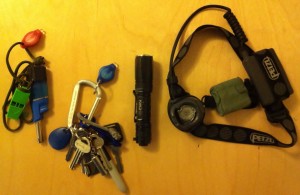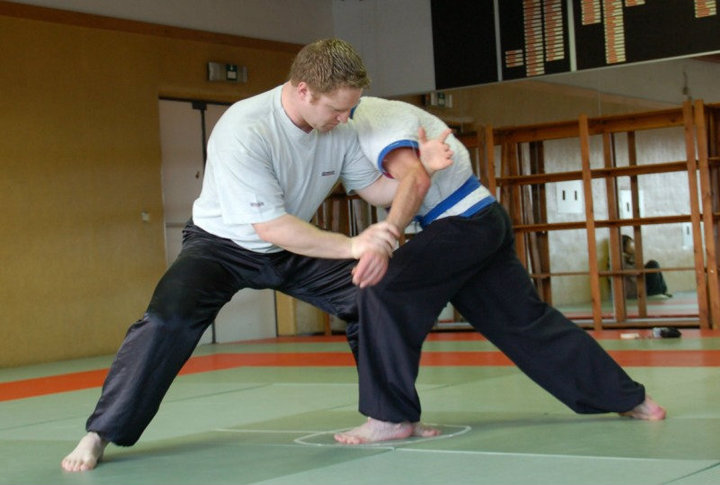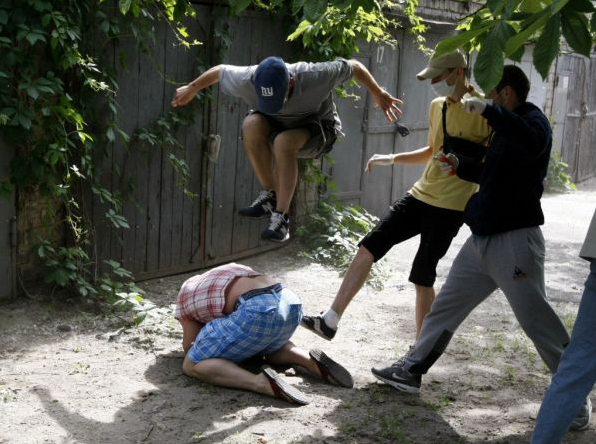Normal vs. Abnormal Behavior
The next step is to be able to identify types of behavior to avoid. To do this, we first have to recognize the things we already know, but don’t know we know. That is, we need to recognize Normal Behavior. For the sake of self defense Normal means not harmful or potentially dangerous. Spastic dancing or other attention getting behavior is quite normal in New York City where I grew up. You know what normal behavior looks like for a time and place, you just may or may not be able to articulate it. You may get an odd feeling when something isn’t normal, and that’s a start, but while you’re pausing to assess that feeling and whether or not to act on it, he’s getting into position.
Since it’s impossible to articulate all abnormal behavior, let’s clarify what normal behavior looks and feels like, so that when you see something that isn’t it, you recognize why. Pick a place and ask yourself what is normal behavior for that place. Imagine you are at your child’s soccer meet. What is normal behavior for a soccer field? Envision it. What is happening? Are planes landing? People on soccer fields mostly play soccer and spectate. A bunch of people may be using their phones to take pictures or tell family members who couldn’t make it what is going on. The kids who aren’t playing will be running or climbing on the bleachers.
What would be odd in this environment? What would bring your hackles up? What would look out of place? Would a lone older man standing separate from the crowd but intently watching the kids cause you to look closer? He might be a grandparent. Would a guy loitering around the parking lot just outside the field looking nervous and chain smoking make you watch more carefully?
It is very important that we not judge people but rather tune into our awareness. There is a fine line. Observe and take action if necessary, do not react to first impressions. All we are doing is taking something that normally hangs out at a low level of consciousness and moving it up for a moment into the spotlight so we can give it a name.
This simple thought process can work in many situations. Once you know the difference between, “normal” and “abnormal” you can also begin to articulate the difference between flirting and probing or asking and manipulating or between your boss calling you out for a reasonable short coming and his stepping over the bounds to something more personal or devious like coercion.
The 15 Foot Rule
Especially if you are in a Fringe Area or vulnerable position, you need to keep your distance from anyone even vaguely suspicious. Distance is your best friend. Do you want the lion next you or on the other side of the river?
Marc MacYoung recommends not letting him get within 5 feet of you. For man-on-man violence with slightly different cues and intentions that may be sufficient. I highly recommend women use the 15 feet rule.
According to law enforcement statistics, a criminal can close 20 feet in a second and a half on average at top speed. 15 feet gives you approximately one second if he lunges, but a second is a long time if you are already aware there might be danger. It is not enough time if you are clueless, but it is difficult to speak to someone further away, so 15 feet seems like the most reasonable distance to work with and reasonable is often the best we can hope for.
In practice here is what it would look like: A man employs the Positioning strategy known as Closing. He walks toward you, appearing to be in a rush, pointing at his watch. He says or implies, “It’s broken, do you have the time?” You are a woman alone in an underground parking facility (Fringe Area) and this makes you uncomfortable, though you aren’t sure why, other than the fact that you are a woman alone in an underground parking facility, which is enough. You have also caught the “it’s broken” and registered it as possibly a bit too much pre-thought information for the moment; too much information can mean lying and you have made a note of it. You employ the Progressive Fence by putting your hands up to show discomfort (Visual Fence). You have set a boundary. You can say, “Stop, talk to me from there,” (Verbal Fence)
Now, he might pretend he doesn’t speak the language, although you know that everyone reads distress language and stop signals pretty much the same way. He might pretend not to notice. How will he do this? Any way that will work! He might pretend he’s looking at his phone and doesn’t see you. He might pretend he needs help and that gives him the right to disregard your hands. You are aware that he is continuing to close distance. In some cases, a potential criminal might look past you as if planning to walk by, yet you can tell he’s focused on you even though he’s not looking at you. Maybe it’s because you look exceptional this morning, maybe not. Is he just one of those people acutely unaware of personal space? Do you want to stick around to find out?
This is what fifteen feet can do for you. It gives you time to calculate.
Whatever this particular potential criminal does, you now have several cues to work with. Cue number one, you’re in a fringe area and anyone who understands the most elementary thing about human interaction understands that you don’t stroll up to woman in a deserted area under any circumstances. Cue number two, he ignores your body language and boundaries. Cue number three, he ignores your words. This alone labels him as a predator unless he is completely clueless, drunk, desperate or otherwise impaired. Either way, no need to stick around. If he is really in need of help he can tell you from a distance. If he is so desperate that he needs to get that close, remember that a drowning person will drown you as well.
In the unlikely instance that you are confronted by a master criminal pretending to be old, infirm or blind, you will just need to use all we have discussed and be a good interpreter of human behavior. What if he breaks into a run and comes at you from fifteen feet or less. It comes down to your awareness, knowledge of exits, and your reaction time. There are lots of ugly possibilities. Luckily most of them are very rare. He will probably walk right by as if you weren’t there. Most people are not after you. If he is a predator, your awareness alone might informed him that you aren’t his girl.
In general if someone ignores your boundaries, get out. Get in your car, lock the door and drive. What you don’t want to do is stand there thinking to yourself that you’re probably just exaggerating or you don’t want to be impolite. Denial is common in unfamiliar situations. The remedy for denial is to heed your instincts and cues.
Let’s for a moment assume you are imagining things. Let’s assume that the guy walking toward you in the dim and deserted garage just doesn’t notice you. He also won’t notice you’re not there.
Fear of social embarrassment is a survival instinct. Not that long ago if you weren’t part of a hunter/gatherer group, you wouldn’t last long. If your group ostracized you, you starved, died of illness or were eaten by wild animals. So fear of public speaking goes back a ways. No one wants to act crazy or be labeled crazy, but there are times to disregard or override this fear. Remember the person walking toward you is someone you don’t know and are unlikely to ever see again. Do you really care if he goes home and tells his wife this crazy lady ran from him in the parking lot for no reason. She may even be likely to ask him if he got too close to you and enlighten him. And you’ll never know. Give yourself permission to act stupid if this sort of thing ever happens. Seriously. Do it. Say it out loud, “I am allowed to run away, slam my door or whatever I feel is necessary, if I feel in the least bit threatened. It doesn’t matter what I look like when I do it. I am not that person, this action does not define me. I am only doing the right thing at that moment by heeding my instincts and my training.” If it helps, pretend you’re late for something.
This may seem like a lot to remember – only you already know it. Just practice articulating behavior, context and intuition silently in your head and you will begin to create a consciousness around it. Once you create that consciousness, it will be relatively easy to pick out the cues of Intent, Interview and Positioning.
Non-Violent Disruption
Now that you know what Positioning looks like and how to articulate it, how do you Disrupt him before he gets into Position?
Obviously in real life rather than a classroom violence can get you into trouble even if you are in the right. It’s only your opinion after all. If you are female against a male you have a better chance of convincing people you were the one in danger, but let’s agree that if you can get away without leaving your fingerprints on the murder weapon it is preferable.
At the Positioning stage, talking is unlikely to help. He has already Interviewed you and determined you have what he wants. Some people recommend vomiting or acting crazy, but I have yet to meet anyone who can vomit on command and crazy people are attacked and raped all the time. In face, mentally ill and handicapped people are groups at high risk of abuse. If you have complete conviction, there may be situations in which you can Disrupt by bluffing. You might look over the criminals shoulder, yell police, or say something about that being the third unmarked car in that last few minutes. It is possible that some version of this might do the trick, but you had better be an excellent actor even under duress. If it works, he was probably either still interviewing you or he wasn’t highly motivated.
Running
Let’s discuss the art of the quick getaway. Once you realize you are in danger, you want to act quickly. One of the best strategies is to get out of the situation. Move. Make like a tree and leave. It’s pretty hard to get into trouble if you’re not there. If your chosen strategy is running, practice it. I don’t mean train for the Olympics or run a marathon, I mean practice sprinting. See how quickly you can take off. Practice against someone else, preferably someone bigger than you are, with bigger muscles and longer legs. Running away is a completely legitimate and honorable self defense technique! But you need to know how good you are. Running may not be your thing. If it isn’t, don’t count on it working for you in a pinch. Adrenaline doesn’t always make you super fast or super strong, sometimes it makes your legs weak and wobbly.
Noise
Screaming can get attention if you are in an area where screaming gets attention. There are places where people ignore car alarms, cities usually. If you are at a ballgame no one may notice. A good blood-curdling scream might create an opening for escape by jarring your assailant. But you must have an escape plan since screaming alone won’t necessarily cause him to end his plan to harm you, it might even cause him to harm you faster.
Another option is a sort of bark that off-balances him – a big loud guttural sound. You want to engage his flinch response. While he is recovering from the jamming of his signals, you should be running away, closing and locking the door, jumping out the window, whatever. This is more easily accomplished by men with deeper voices. I myself have not garnered anything but a kind of stare, whereas Rory Miller once demonstrated his barbaric yalp, which had the desired effect on my flinch response.
If you have a whistle use that, but if I were reaching into my bag for something and I thought I was in danger, it wouldn’t be a whistle.
All bets are off in practice. I wouldn’t count on a strategy like making noise if I had other options. Certainly use noise in addition to other things. But we are talking about non-violent options that might save us from having to fight our way out of a life-threatening situation and there aren’t many of them. If you don’t have an escape plan, all of this noise is of course contingent on whether or not there is anyone helpful around you to hear it.
Next, we Disengage the Attack….





